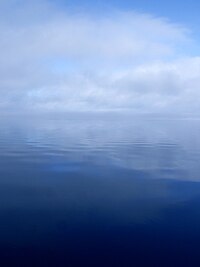
Photo from wikipedia
The presence on the surface of Mars of ferrihydrite, a nanocrystalline iron oxide species, has long been suspected from spectroscopic observations and is further suggested by recent results from the… Click to show full abstract
The presence on the surface of Mars of ferrihydrite, a nanocrystalline iron oxide species, has long been suspected from spectroscopic observations and is further suggested by recent results from the MER (Mars Exploration Rovers) and MSL (Mars Science Laboratory) robotic missions. However, because ferrihydrite is a metastable species in terrestrial environments, it is unclear what would have been its fate during episodes of water/rock interactions that are known to have occurred at the landing sites of the above-mentioned robotic missions. Accordingly, the laboratory experiments presented in this paper investigate the recrystallization of ferrihydrite under various conditions applicable to early Mars. These included low-temperature experiments (one month at 40 °C) at pH ranging from circum-neutral to strongly acidic, and high-temperature experiments (8 days at 150 °C) at circum-neutral pH. The effect of mixtures with other mineral phases (namely, amorphous silica and olivine) was also tested. Results obtained at low temperature are at odds with some earlier studies and suggest that ferrihydrite behaves differently in rock-dominated conditions compared to water-dominated conditions. The co-existence of amorphous silica favored the formation of jarosite under low-temperature, acidic conditions, whereas a sample of pure ferrihydrite produced only goethite under the same conditions. At high temperature, ferrihydrite converted into hematite in all samples, but the ferrihydrite-silica mixture led to hematite with much broader diffraction peaks than other experiments, indicating an inhibiting effect of dissolved silica on the recrystallization process. The implications of these results for the aqueous history of early Mars are discussed.
Journal Title: Journal of Geophysical Research
Year Published: 2017
Link to full text (if available)
Share on Social Media: Sign Up to like & get
recommendations!